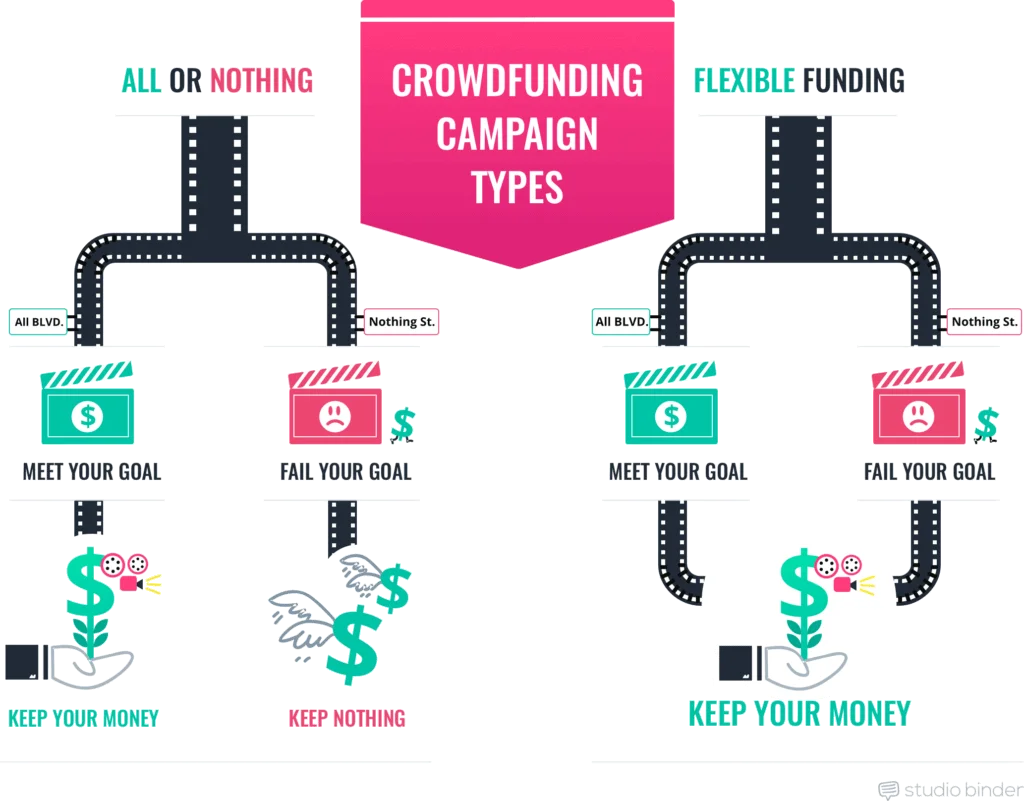M
ost filmmakers I know have tried and failed at crowdfunding. I failed, too, on my first attempt. But every time I researched shot film funding, crowdfunding was one of the first recommendations. It has become a ubiquitous film funding technique.
So, I tried crowdfunding again. I studied successful crowdfunding campaigns and took courses on strategy. Ultimately I raised over $18,500 in short film funding for “The Pirate Captain Toledano.” Crowdfunding can be an incredibly powerful film funding tool – if you do it right.
Here are some of the most important things I learned from my crowdfunding campaign. These are strategies and techniques that you can apply when you crowdfund your short.
Crowdfunding Movies
What is Crowdfunding?
Crowdfunding definition, according to Wikipedia: “Crowdfunding is the practice of funding a project or venture by raising many small amounts of money from a large number of people, typically via the Internet.”
You’ve probably heard of crowdfunding sites like Kickstarter and IndieGoGo. You might have even contributed to campaigns.
But it’s a whole different ballgame when you have to do it yourself.
CROWDFUNDING MOVIES
How does crowdfunding work?
It’s fairly simple. You start by setting a fundraising goal (your “goal amount”) and a timeframe (your “campaign duration”) within which you must reach that goal.
Next, you also pick a campaign type:

Crowdfunding Campaign Types
- “All-or-nothing” (if you don’t meet your goal, you get nothing)
- “Flexible funding” (if you don’t meet your goal, you get some money anyway).
You’ll build a website where people can contribute money towards that goal.
Typically you’ll use a “crowdfunding platform” such as Kickstarter or IndieGoGo to do the heavy lifting for you. In fact, they’re so ubiquitous, that when you ask people “What is crowdfunding?” their first thoughts are those websites.
Through that website, you offer “perks” or “rewards” for people who contribute to your campaign.
By any means necessary, including word-of-mouth, traditional and social media, you tell everyone you know about your campaign and invite them to contribute.
If you’ve done it right, those people will tell their friends, who tell their friends, and before you know it, a “crowd” has “funded” your project. Hence the crowdfunding definition
It sounds really simple, but to do it right, you’ve got to start with one tough question.
CROWDFUNDING MOVIES
Will crowdfunding get you short film funding?
So we’ve answered our first questions. What is crowdfunding and how does it work.
But while crowdfunding is a great new way to raise money for short films, it’s not a perfect fit for every project or every filmmaker.
The next question is: how do you know if crowdfunding is right for you?
There are many considerations, beyond the simple numbers, that will influence whether or not your campaign will work. What’s the subject matter of your film? Is your target audience specific? Focused? Well-connected?
Always ask yourself, what is crowdfunding? By definition, crowdfunding is convincing people, often people you don’t know, to give you money.
As a result, “activist” projects tend to fare better when it comes to short film funding. “Pure entertainment” is a harder sell.
CROWDFUNDING MOVIES
Crowdfunding calculators
I suggest starting with a crowdfunding calculator to estimate the potential of your campaign.
What is a crowdfunding calculator? It’s a tool that takes in several factors to determine how much money you can raise on average.
If you’ve already prepared a preliminary production budget for your short film, you can assess how likely you are to crowdfund the money that you’ll need.
If you haven’t budgeted yet, these crowdfunding calculators can give you a rough sense of how much short film funding you can get. You can use that to seek out only the short film ideas that fit.
Crowdfunding calculators are useful (albeit imperfect) tools. They allow you to input some fixed variables (such as how many Facebook friends or Twitter followers you have).
Alongside the fixed variables, they also ask for some process estimates (such as how much time per day you expect to devote to your campaign while it’s live).
The calculators then estimate (based on statistical analysis of previous campaigns) how much money you might be able to raise. For “The Pirate Captain Toledano”, I used the crowdfunding calculator at Jewcer.
The calculator at Jewcer utilizes data from their own crowdfunding platform to generate campaign success estimates. Other calculators, such as Crowdfunding.io, draw their data from platforms such as IndieGoGo, Kickstarter, and GoGetFunding.
Every calculator is different and weighs the data differently. For example, the Jewcer crowdfunding calculator gives more weight to the amount of time you commit to a campaign.
Spending more time on a campaign has a bigger impact than having more Facebook friends, for example. Understanding campaigning is an essential part of answering the question: “How does crowdfunding work?”
And the calculators can be ‘pessimistic’ or ‘optimistic’. The Crowdfunding.io calculator estimates much higher success rates than the Jewcer calculator.
Try a few different calculators to see if you have the social media reach, time and resources that are necessary for a campaign to be successful.
A note on time
Crowdfunding a movie takes a lot of time! It’s not by chance that many crowdfunding calculators ask how much time you (or your team) can commit per day or per week of your campaign.
Many successful crowdfunding campaigns that I’ve studied required at least one person to work nearly full-time to keep up with the campaign’s demands.
If you’re hoping to simply push the button and watch the money roll in, crowdfunding is probably not your best film funding option.
CROWDFUNDING MOVIES
Study successful crowdfunding campaigns
Study! Study! Study!
Crowdfunding online is a relatively new phenomenon. But independent film crowdfunding has been around longer. The crowdfunding definition never says it has to be done on the internet, after all.
There are already tens of thousands of successful short film crowdfunding examples that you can study.
Most crowdfunding platforms don’t delete their campaigns after they’ve reached their deadline. Doing a post-mortem on those campaigns is a great way of learning how crowdfunding works.
Start by searching for films that are similar to yours. Which campaigns were successful? How much money did they crowdfund?

Crowdfunding circle
Here are a few questions to consider when studying campaign success stories:
What was their video like? Was it short? Long? Funny? Serious? Glossy? Personal?
- What sorts of perks or rewards did they offer?
- What were the most popular contribution levels?
- What were the most lucrative contribution levels? (100 people might have contributed at the $5 level, but the one person who contributed $750 made that contribution level more lucrative).
- How much did they write to describe their film?
- What language did they use for the ‘ask’? (did they ask for money, or offer an opportunity to get involved? Did they seem pleading and weak, or confident and strong?)
- What sort of artwork did they incorporate into their campaign? Was there a consistent visual ‘look’ - fonts, logos, color schemes? Were there compelling images that helped sell their message?
- Did they have some sort of ‘popular hook’? A celebrity attachment or endorsement? A particularly exciting perk? Something aside from the narrative content of the proposed film that would inspire contributors?
- How did they describe the campaign?
- How did they inspire people to click on links or check out the campaign page?
- How frequently did they post about the campaign?
- What information did they provide in social media that wasn’t posted to their crowdfunding platform?
- Look at who responded to the social media posts. Is there a core group of dedicated people who respond to everything? How many are there? Are they involved in the project or just early fans?
Look beyond the crowdfunding campaign page
When you find a crowdfunding campaign that you particularly like, look beyond the crowdfunding platform for more information.
Study the Facebook, Twitter and Instagram accounts of successful campaigns.
Always remember: What is crowdfunding? It’s getting your short film funding from the crowd. And where does the crowd live these days?
That’s right. Social media.
If the campaign you’re looking at is a few years old, you might have to scroll through a lot of posts before you get to the ones that matter.
Once you find the social media posts that coincide with the crowdfunding campaign, some of the same questions apply:
If you spend enough time doing this, especially for campaigns raising short film funding, you’ll begin to notice patterns. You’ll get clues as to what carried successful crowdfunding campaigns across the finish line.
If you can stomach it, look at some failures too. It can be telling to look at a campaign that didn’t crowdfund enough money. You can dissect what went wrong and to try to figure out what could have been done differently.
Contact successful crowdfunders
There are some things that you can’t know from looking at a campaign page. Did the campaign pay for online ads? Did they hire a campaign manager?
How much time did the filmmakers commit per week to running their campaign? How much time did they spend preparing for it before it launched?
Essentially, how does crowdfunding work for successful crowdfunders?
The best way to get the answers to these questions is to contact the filmmakers! Most campaigns list some sort of contact information, so it’s relatively easy to connect with the people behind them.
Some filmmakers or campaign managers might not like to give away their independent film crowdfunding ‘secrets’. But in my experience, most are happy to share their success stories with anyone who’s willing to listen.
Once you’ve studied other people’s campaigns, you’ll begin to have an idea of whether or not crowdfunding is a good choice for getting your short film funding.
Put another way, you’ll begin to figure out whether or not your short film idea is a good fit for a crowdfunding campaign!
CROWDFUNDING MOVIES
Not all short film ideas are created equal
If you’re having a hard time finding successful short film funding campaign for shorts that are similar to yours, there might be a reason. Some films are simply harder to excite people about.
By the crowdfunding definition, you need a crowd to fund you. If there isn’t one that already exists, you’re going to have to build it.
If you’d like to give crowdfunding a try, and you have the flexibility to choose between a handful of short film ideas, you should choose the idea that is best suited to a crowdfunding campaign.
Outside your circle of immediate family and close friends, there are two primary factors that will inspire people to contribute to your crowdfunding campaign - and they’re closely connected.
Supporting a cause
It helps if you can align your short film with a social or political cause, especially if you’re already connected to organizations that support or champion that cause.
Always remember the crowdfunding definition. Where are there existing crowds you can draw from?
If your film is about an abused dog, you can tap into pre-existing networks of people who support abused animals, or who donate to animal shelters.
If you know people in those groups who can share your campaign within their network of animal rights supporters, it’s even better - you have a foot in that door. You’ll have your short film funding in no time.
Sometimes, great entertainment can be a cause in and of itself! You want to make a great American noir classic like they did in the ‘40s. Luscious black and white footage, tough and stylized dialogue, and a dame to kill for.
But if that’s your “cause”, make sure you know where the fans are and how to reach them. Who are the people who love those ‘40s noir films? How will you be able to get their attention?
Contributing to innovation
In addition to having a ‘cause’, it can be very helpful to pitch a project that is innovative. If you don’t have an already existing crowd, you’ll need to build one.
It’s just how crowdfunding works, and you’re far more likely to inspire contributions from people if they feel they’re participating in something new:

Word Bubbles
- “Join us as we produce the world’s first film about _________”
- “Come aboard the first ever movie shot entirely in a ___________”
- “Join us as we bring ____________ out of retirement to make this important film”
Sometimes, the innovation is also of social interest. I pitched my short as “the world’s first film about Jewish pirates”. It touched on both an innovation (“first film about…”) and a social issue.
Namely, bucking the Hollywood patterns of how Jewish characters are portrayed.
As you review short film ideas for your next crowdfunded project, look for innovative ideas that may excite an interest group.
CROWDFUNDING MOVIES
Know your target market
Before you design your crowdfunding campaign, you need to understand who you’re designing it for. This is really, really important, and it will come up again and again, so I’ll write this in bold:
Who is your target market? Who are you trying to reach?

Finding Funders
Yes, understanding the interest groups that are most likely to support you is important here, but I’d like to break this down a little differently.
Your short film funding campaign’s success hinges on three types of people:
- People you know very well (they’ll give you money for almost anything, not because they believe in the project or care about the subject, but because they care about you!)
- People you sort of know (social media contacts, most friends and acquaintances, etc.)
- People you don't know at all
Direct contact: People you know very well
This group is very important. They won’t crowdfund your entire project, but they will prime your campaign. Their initial burst of funds makes it look viable.
The most important thing to know about the people who know you very well is that you’ve got to reach out to them directly.
It doesn’t matter how awesome your crowdfunding campaign page is, or how compelling your campaign video is. If you don’t reach out directly to the people closest to you, they might never know that you need their help.
Make a list of the people who you believe will definitely crowdfund something to your campaign, just because they know you. Gather their email addresses and phone numbers so that when it comes time to contact them, the info is within easy reach.
Indirect contact: People you sort of know
This group is composed of everyone else you know. They will crowdfund a significant portion of your short film funding, but probably not right away. They’ll want to see that you’re succeeding before stepping in to help out.
This the majority of the crowd people think of when they ask “what is crowdfunding?”
You probably won’t reach out to most of them directly, but you need to know where they are, and how they get information.
Are there Facebook groups that many of your acquaintances have joined? Are there email lists through which you could reach them? Start listing these.
Sure, many of these people are connected with you directly on social media. If you post about your campaign to Facebook, they may see the posts and contribute.
But if you know what groups they belong to, and you post there, you increase the likelihood that they’ll find out about your campaign.
Remember, these are the people who might not click the link the first time they see it. They might need to see your project come up again and again in several different contexts before they decide that it’s of interest to them.
Within this group, there are some people who you should contact directly. These are people who have a direct interest in the subject matter or content of your film.
For example: let’s say you’re making the abovementioned film about the abused dog. You should directly contact anyone you know who posts about animal rights on social media. Who volunteers at a local animal shelter. Or who donates money to the ASPCA.
Add them to the DIRECT CONTACT list.
Passive contact people you don’t know at all
The most successful crowdfunding campaigns are the ones that draw contributions and support from people well beyond the funder’s immediate social circle. You need to focus your attention on reaching these people, or your campaign will fail.
Who are these people?
This is where understanding your campaign’s target market is important.
Note: your campaign’s target market is not necessarily the same as your film’s target market. Let’s say your film is a redemption story for poor inner-city kids. Clearly, the people who will fund your campaign won’t be poor inner-city kids.
Who are the people (subdivided by age, gender, culture, religion, or any other parameter that provides you with useful information) who are most likely to contribute because they want to see this film get made?
This is the most difficult group of people to reach because you don’t know them and they don’t know you.
But you can find out what blogs or newspapers they read, what groups they belong to, and which opinion-makers carry weight with them.
Make a list of the opinion-makers who you’d like to contact about your campaign, but...
Don’t contact opinion-makers too early!
DON’T contact any of these opinion-makers at the beginning of your crowdfunding campaign!
Opinion-makers (whether they’re pundits, bloggers, celebrities, experts, or community leaders) have a reputation to maintain. They’ve also likely been around the block a few times.
They understand what crowdfunding is, and they’ve been asked to help promote a campaign for short film funding before.
They don’t want to be seen backing a loser.
Reach out to them ONLY when you have undeniable evidence of your campaign’s success, such as when you cross a significant funding milestone. When crowdfunding a movie seems less like a pipe dream and more like serious business.
Once you’ve gotten one opinion-maker to blog about, tweet about or post about your project, try to map out which other opinion-makers on your list respond positively to the first opinion-maker, and reach out to them.
Up Next
How to Write a 4-Part Film Business Plan That Gets You Funding
You now understand the crowdfunding definition - do you think you can find or build a crowd for your film
You’ve studied successful crowdfunding campaigns - do any of them look like campaigns you could run?
You’ve assessed your own short film idea - is it so compelling that people will spend money to make sure it’s produced?
You’ve analyzed the target market - do you know where and how to find the people who are most likely to contribute to your crowdfunding campaign?
If so, you might be ready to build your campaign!
If you haven’t done so already, you should put together your business plan so you can clearly define your goals and your audience.
Then, take your time to craft a specific, targeted crowdfunding campaign that introduces your film to the people who are most likely to support it.
Break a Lens!
Up Next: How to Write a 4-Part Film Business Plan That Gets You Funding →
Project management for video creatives. Tasks, file sharing, calendars and more.
Manage video production timelines, tasks, storyboards, shot lists, breakdowns, call sheets. Made for video creatives, new media and film.

Hi Arnon,
Very helpful tips here.
I have been working on a project for eight years till now documenting across the country the plight of women in their daily quest to provide food for the families in the face of the impact of climate change.
The project a short documentary called Women under the Spell, Climate Change Women, and food security in Papua New Guinea.
Until recently my application for funding to a donor that support short video documentaries on social issues have turned down my proposal.
Regards,
John